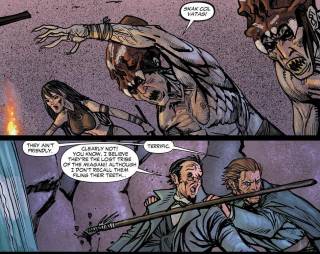
Indigenous People
Groups of people who live outside of civilization and are often stereotypically depicted as savages. In comics they can play the roles as villains' minions or spiritual guides for heroes.
- Aboriginal Groups
- Aborigines
- Natives

Indigenous people can be found in almost all parts of the world. In comics (or popular culture), the most commonly shown groups are jungle tribes (mostly from South America), Australian aborigines, Native Americans or tribal people in Africa. Sometimes tribes are made up but are obviously based on customs of known aboriginal groups (see also: Clandestine Races).
Minions

Often villains take advantage of the supposed naivety and use them as minions for their evil schemes. They help erect lairs or castles, are used as cannon fodder for super-heroes or sacrificed. This degrading image can mostly be found in older comics up until the 1960s. In modern comics this sometimes is still an issue, especially when the villain is located in the "Amazon jungle" because people living there are still primarily considered primitive and therefore prone to abuse.
Savages

Under certain geographic circumstances (jungle, caves, desert, ice) indigenous people serve the function that wild animals (lions, sharks, dinosaurs) normally fill. They are feral and dangerous, they attack without asking and can only be defeated or have to be escaped. They have no language and seem to consist only of instincts for killing, eating and sometimes mating. There are no individuals with personalities, just a threatening group of people.
A prime example are the neanderthals in Palmiotti and Gray's Retrovirus.

Noble Savage

A stereotype that exists since the 1700s and that envisions a "savage" (a member of an indigenous group) that embodies both the savageness of nature but also an inherit wisdom that civilized people can't gain. While this seems to be a rather positive image, most depictions make it clear that these creatures are destined to be doomed. They are too much part of an extincting race despite their supposed wisdom. Noble savages are also often shown as leaders of a group that is less enlightened, single individuals that are special for their group. This stereotype has mostly survived in depictions of Native Americans.
If there are indigenous superheroes, they often fit in this category, for example the short-lived X-Man Thunderbird or Ka-Zar from the (appropriately named) Savage Land.

Neutral Observers or Victims

In some cases indigenous people are just standing around in the background, observing what the main characters are doing. Sometimes they just serve as victims for threats or monsters that are just collateral damage as all the animals and plants around them.


Realistic Depictions

Most rarely, indigenous people are depicted realistically, showing either their culture with a certain respect or showing the problems they still face today, e.g. life in reservations or the destruction of their environment.
Examples are depictions of Native American reservation life as in Jason Aaron and R.M. Guerá's Scalped or Grant Morrison and Chris Burnham's Batman Incorporated #7 and the portrayal of Australian Aborigines in Brian K. Vaughan and Pia Guerra's Y: The Last Man or 52 #28.